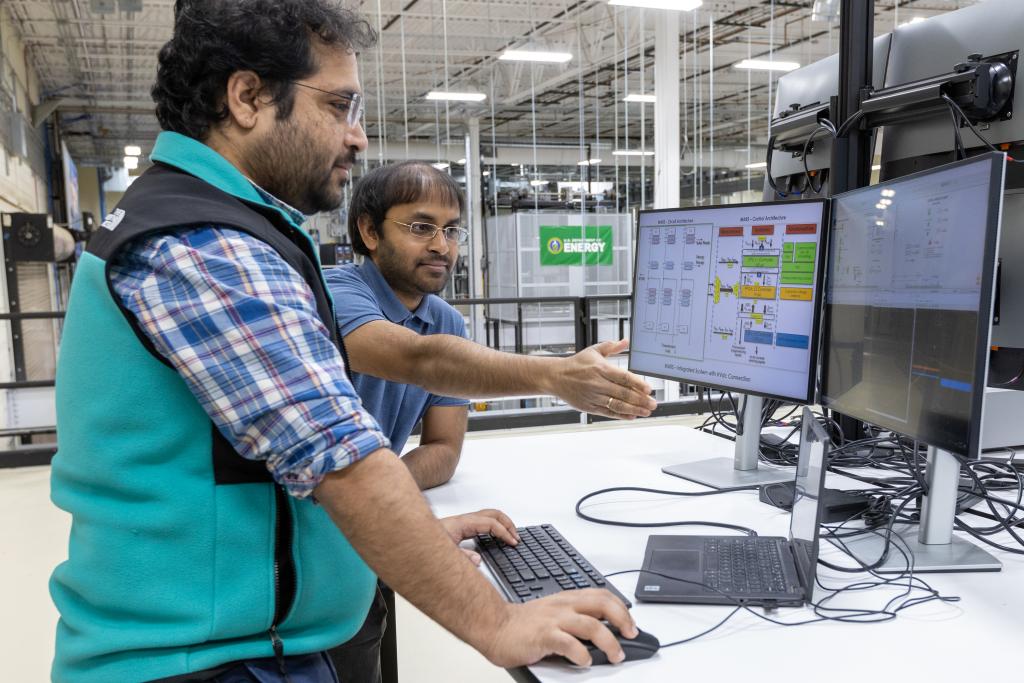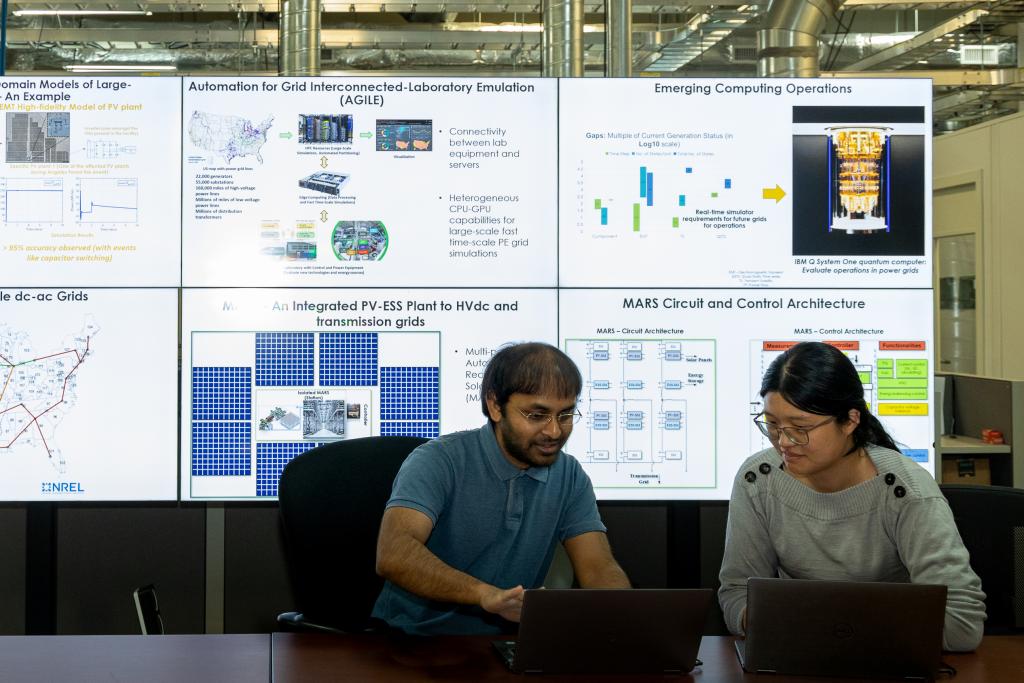
Library of Advanced Models of large-scale PV plants (LAMP)
A library of different types of dynamic models for photovoltaic (PV) plants was developed to accurately capture system operating dynamics during various situations. The models were crafted with the flexibility to incorporate different control functions at different levels and then evaluated using present and future scenarios. The project substantially accelerated simulation times based on advanced simulation algorithms for PV plants to 326 times faster than when using baseline models. Moreover, the model helped with replication of a real-world event. The advanced control functions incorporated into the new models help mitigate present problems in PV plants, such as operation interruptions due to external faults.
Sponsor: Department of Energy (DOE), Office of Energy Efficiency and Renewable Energy (EERE), Solar Energy Technologies Office (SETO)
Automation for Grid Interconnected-Laboratory Emulation (AGILE)
At ORNL’s Grid Research Integration and Deployment Center (GRID-C), researchers studied the challenge of emulating – and automating emulation – of real-world energy systems. The project focused on scalable, dynamic EMT simulation of the power grid using real-time edge computing. The simulation provides a realistic set point to evaluate a small portion of the power grid in laboratories and provide feedback to the simulations. This connectivity between the simulations and hardware is established through stable, low-latency data exchange between these resources. The automation includes mapping of a real-world energy system and a power grid to scalable power grid dynamic simulation and partitioning in different GRID-C laboratories.
Sponsor: Laboratory Directed Research and Development (LDRD), INTERSECT
Enhanced Observability of Power Grids
Researchers are developing a tool that models how inverter-based resources would respond to different disturbance events in the electric grid, providing recommendations to grid operators on how to mitigate the impact of these events. The project will supplement real-world grid data from utility partners with large amounts of data from high-fidelity EMT simulations to replicate events and train detection models. The tool will provide insights into the impact of inverter-based resources on the grid while improving the accuracy and computational speed of analysis.
Sponsor: Department of Energy (DOE), Office of Energy Efficiency and Renewable Energy (EERE), Solar Energy Technologies Office (SETO)
Research on Application of Advanced Computing Capabilities for Future Grid Simulations (Operations)
Researchers perform early-stage evaluation of computing architectures to understand their suitability for performing EMT simulations, potentially in real time. The project helps build industry confidence in the feasibility of modeling power grids even when they are permeated with inverter-based resources, such as renewable energy sources and storage.
Sponsor: DOE Office of Electricity (OE), Advanced Grid Modeling (AGM)
Grid Research Integration Deployment – Quantum (GRID-Q)
This project advances quantum technologies in the power grid through the development of several use cases in computing, security/communication, and sensing. Quantum technology and power grid simulation will complement these efforts. The project encompasses plans for an applied quantum facility for electric grids that will enable more rapid research, development, and transfer of quantum technologies to the grid.
Sponsor: Grid Modernization Laboratory Consortium (GMLC)

Scalable Hybrid Large-Scale DC/AC Grid Analysis Methods
This project identifies and evaluates voltage-source converter–multi-terminal high-voltage direct current (VSC-MTdc) system architecture suitable for high-power transfer through long transmission lines. To achieve this, the team is developing both new technologies and simulation methods to measure their impact. Researchers determine optimal converter arrangements and control/protection systems for substations that support higher-power transfer. Researchers also develop approaches for measuring the economic benefits of direct current transmission and for measuring the broader benefits of DC protection configurations.
Sponsor: DOE Office of Electricity (OE), Transformer Resilience and Advanced Components (TRAC)
Operation of Vendor-Agnostic MTDC-based Offshore Wind Integration
Researchers are developing and evaluating a test simulation platform, a hierarchical control system, and component requirements for simulating operations of a multi-terminal DC (MTDC) system made by any vendor. The evaluation process will help define national standards so these components can be interoperable across any MTDC platform.
The approach boosts the viability of wind generation projects in the grid by increasing the flexibility, reliability, and ease-of-maintenance of an MTDC system. Researchers aim for 10% improvement in reliability measurements, such as reducing transient energy imbalance and the time need to restore DC voltage. Among other intended advances, goals include improving power transfer by 30% during fault conditions.
Sponsor: Department of Energy (DOE), Office of Energy Efficiency and Renewable Energy (EERE), Wind Energy Technologies Office (WETO)
Flexible, Intelligent, Real-Time DC-AC Grid Emulator (FIRE)
Grid modernization is leading to increased penetration of power electronics in existing alternating current (AC) grids through direct current (DC) interconnects, solid-state power substations, and extreme fast chargers for electric vehicles. These technologies respond at time scales ranging from microseconds to hours, requiring a platform that can emulate this range of dynamic interactions among power electronics hardware in real time.
Researchers developed the FIRE platform to overcome challenges related to latency in hardware dynamics, communication links, and computational platforms, as well as the high computational demands required in the microsecond time range. The foundation for the FIRE platform consists of a power electronics hardware-in-the-loop (PE-HIL) test bed for a modular multilevel converter substation. Multicore digital signal processors and graphics processing units (GPUs) are used to power the modeling algorithms, enabling fast simulation in multiple timescales. The approach also includes high-speed communication and wide-bandgap power hardware, which enhances dynamic response to reduce latencies.
Sponsor: Laboratory Directed Research and Development (LDRD)
HVDC Models and Methods
When direct current systems overlap with alternating current systems, DC can provide rapid, essential services to the grid while moving blocks of energy. This project created models and utilized a variety of tools to explore the technical and economic benefits of DC technologies, which offer greater power control flexibility and faster response capabilities.
Sponsor: Grid Modernization Laboratory Consortium (GMLC), DOE Office of Electricity (OE), Transformer Resilience and Advanced Components (TRAC)
Multi-port Autonomous Reconfigurable Solar power plant (MARS)
This project focused on integrated development of solar photovoltaic (PV) plants, energy storage, and AC/DC systems to avoid the instability that can result from duplicated controls in separately-developed components. Integrated development reduces costs, improves the efficiency of operation, and streamlines control features. Researchers utilized modular, multi-purpose power electronics, enhanced by new models and advanced controls, to provide additional value-added services to the existing AC grid. They showed the suite of hardware and software saved up to half the costs and power losses of the solar plant when used with integrated energy storage, improving the lifetime value. An enhanced cyber-security system developed in this project reduces the probability of disruptions.
Sponsor: Department of Energy (DOE), Office of Energy Efficiency and Renewable Energy (EERE), Solar Energy Technologies Office (SETO)

